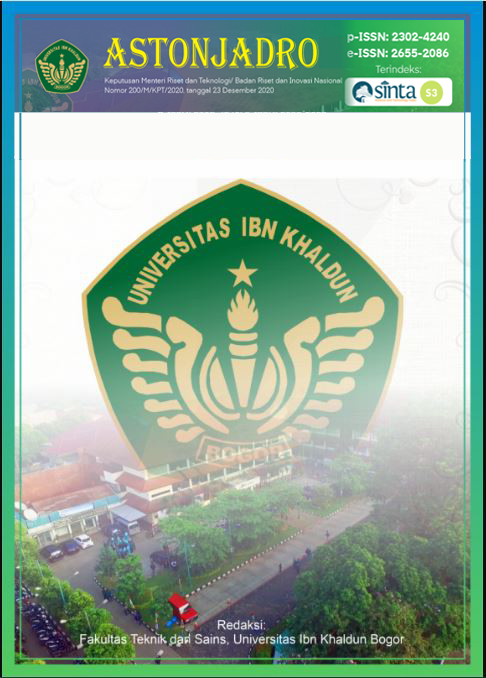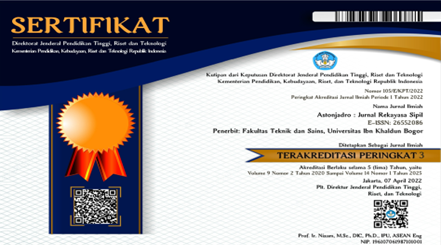Identifying Critical Success Factors in Implementing Green Building, Case Study: Medium-sized Construction Companies in East Java, Indonesia
DOI:
https://doi.org/10.32832/astonjadro.v14i1.16800Keywords:
critical success factors; green construction; mean; medium-sized contractor; questionnaire.Abstract
The construction industry is a significant consumer of natural resources and a contributor to environmental issues and ecological instability. This has led to the emergence of sustainable programmes (green construction) which aim to minimise the impact of development projects. The objective of this study is to identify the critical success factor in implementing green construction and to the extent of familiarity among middle-sized companies in the province of East Java with the implementation of green construction projects and to ascertain the factors that affect the success of such projects. The case study subjects are four medium-sized construction companies in East Java that have experience in implementing green building projects. The data obtained will be analysed on mean using IBM SPSS software on each variable. The results will identify the top five critical success factors based on questionnaires distributed to respondents. The findings of critical success factors are as follows: Integrated planning and/or design, Adequate project funding sources (smooth payments), Classification/capabilities of implementing contractors, Effective communication among stakeholders, Competence and experience of the project manager, and last critical success factor is Applicable policies/regulations regarding green construction. These findings are expected that this research will contribute to a deeper understanding of the critical factors that influence success in implementing green construction projects.
References
AbuMoeilak, L., AlQuraidi, A., AlZarooni, A., & Beheiry, S. (2023). Critical Success Factors for Building Information Modeling Implementation as a Sustainable Construction Practice in the UAE. Buildings, 13(6). https://doi.org/10.3390/buildings13061406
Al-Hosani, A. E. Y., & Rashid, N. B. A. (2021). Conceptual framework of the critical success factors of green building towards sustainable construction in United Arab Emirates. Proceedings of the International Conference on Industrial Engineering and Operations Management, 4455–4463.
Bakkalbasioglu, E. (2020). How to access elites when textbook methods fail: Challenges of purposive sampling and advantages of using interviewees as “fixers.” Qualitative Report, 25(3), 688–699. https://doi.org/10.46743/2160-3715/2020.3976
Ghozali, I. (2016). Aplikasi Analisis Multivariete Dengan Program IBM SPSS 23 (8th ed.). Badan Penerbit UNDIP.
Kementrian PUPR RI. (2015). Peraturan Menteri Pekerjaan Umum dan Perumahan Rakyat Nomor 02/PRT/M/2015 Tahun 2015 tentang Bangunan Gedung Hijau (02/PRT/M/2015; p. 26). BN.2015/No.309, jdih.pu.go.id : 26 hlm.
Kumar, B. G., & Tawalare, A. (2021). Critical Success Factors for Implementation of Green Building in India. IOP Conference Series: Materials Science and Engineering, 1203(3), 032061. https://doi.org/10.1088/1757-899x/1203/3/032061
Lembaga Pengadaan Jasa Konstruksi Nasional. (2013). Peraturan LPJKN Nomor : 10 Tahun 2013 tentang Registrasi Usaha Jasa Pelaksana Konstruksi (NOMOR : 10 TAHUN 2013; Issue 10, pp. 1–191).
Liu, Z. J., Snezhko, V., & Kurilova, A. (2022). International legal instruments for stimulating green building and construction business: Russian case study. International Environmental Agreements: Politics, Law and Economics, 22(1), 157–175. https://doi.org/10.1007/s10784-021-09548-1
Natalia, M., Partawijaya, Y., Mukhlis, & Satwarnirat. (2017). Analisis Critical Success Factors Proyek Konstruksi Di Kota Padang. Jurnal Fondasi, 6(2). https://doi.org/10.36055/jft.v6i2.2632
Nwogu, P., & Emedosi, A. (2024). Barriers to Green Building Project Implementation and Sustainability in the Nigerian Construction Industry 5 PUBLICATIONS 0 CITATIONS SEE PROFILE. Article in International Journal of Progressive Research in Engineering Management and Science · INTERNATIONAL JOURNAL OF PROGRESSIVE RESEARCH IN SCIENCE AND ENGINEERING, 5(2). www.ijprse.com
Prameswari, F. R., Rachamawati, F., Wiguna, I. P. A., & Rohman, M. A. (2021). Importance and Performance Ratings Analysis for Implementation of Green Construction on Building Project. IOP Conference Series: Earth and Environmental Science, 799(1). https://doi.org/10.1088/1755-1315/799/1/012015
Prof. dr. Sugiyono. (2011). Metode Penelitian Kuantitatif Kualitatif dan R&D. In Bandung Alfabeta (10th ed.). CV. ALFABETA.
Sarmanu. (2017). Dasar Metodologi Penelitian Kuantitatif, Kualitatif dan Statika (1st ed.). Pusat Percetakan dan Penerbitan Universitas Airlangga (AUP).
Serra, M., Psarra, S., & O’Brien, J. (2018). Social and physical characterization of urban contexts: Techniques and methods for quantification, classification and purposive sampling. Urban Planning, 3(1), 58–74. https://doi.org/10.17645/up.v3i1.1269
Shan, M., Liu, W. Q., Hwang, B. G., & Lye, J. M. (2020). Critical success factors for small contractors to conduct green building construction projects in Singapore: identification and comparison with large contractors. Environmental Science and Pollution Research, 27(8), 8310–8322. https://doi.org/10.1007/s11356-019-06646-1
Shurrab, J., Hussain, M., & Khan, M. (2019). Green and sustainable practices in the construction industry: A confirmatory factor analysis approach. Engineering, Construction and Architectural Management, 26(6), 1063–1086. https://doi.org/10.1108/ECAM-02-2018-0056
Singh, D., & Singh, A. (2023). Role of Building Automation Technology in Creating a Smart and Sustainable Built Environment. Evergreen, 10(1), 412–420. https://doi.org/10.5109/6781101
Taluke, D., Lakat, R. S. M., Sembel, A., Mangrove, E., & Bahwa, M. (2019). Analisis Preferensi Masyarakat Dalam Pengelolaan Ekosistem Mangrove Di Pesisir Pantai Kecamatan Loloda Kabupaten Halmahera Barat. Spasial, 6(2), 531–540.
Downloads
Published
How to Cite
Issue
Section
License
Copyright (c) 2025 ASTONJADRO

This work is licensed under a Creative Commons Attribution-ShareAlike 4.0 International License.
Paper submitted to ASTONJADRO is the sole property of the Astonjadro Journal. Unless the author withdraws the paper because he does not want to be published in this journal. The publication rights are in the journal Astonjadro.ASTONJADRO
LICENSE
This work is licensed under a Creative Commons Attribution-ShareAlike 4.0 International License.
Based on a work at http://ejournal.uika-bogor.ac.id/index.php/ASTONJADRO













